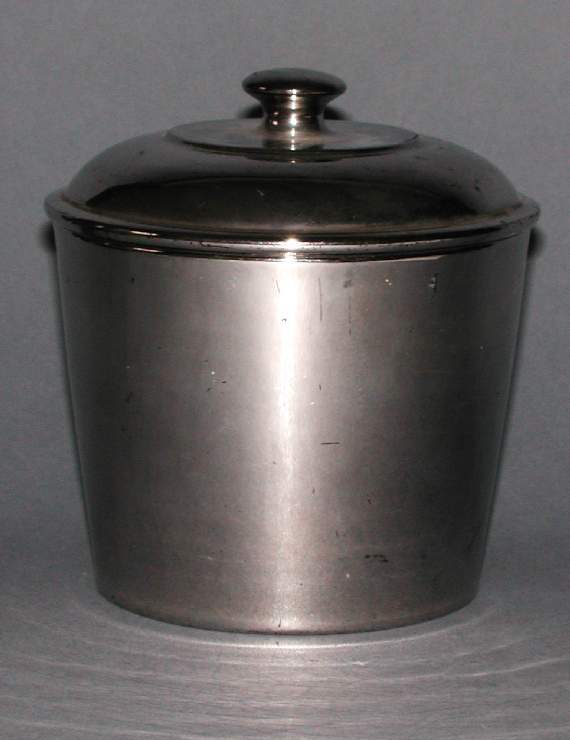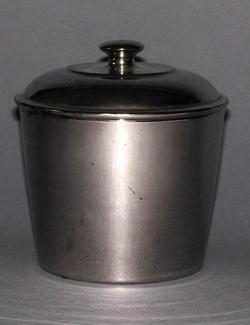Current Location: In storage
Titles
Silver lustre jar and lid
Maker(s)
Unidentified factory
Entities
Categories
Description
Dark red-brown earthenware, thrown and moulded then dipped in silver (platinum) lustre.
Jar or sugar basin with straight sloping sides. Domed cover with flat circle in the centre and a raised, flat knob. The underside is flat with a narrow foot-rim. Both parts entirely coated with silver lustre.
Notes
History note: Bought from Mr Black, Praed Street, Paddington on 19 June 1907, for 30/- (one pound ten shillings), by Dr J.W.L. Glaisher, Trinity College, Cambridge.
Legal notes
Dr J.W.L. Glaisher Bequest, 1928
Measurements and weight
Diameter: 10.2 cm
Height: 10.8 cm
Acquisition and important dates
Method of acquisition: Bequeathed
(1928)
by
Glaisher, J. W. L., Dr
Dating
19th Century, first half
Circa
1820
CE
-
1840
CE
Note
All over lustring was widely used to imitate Georgian silver, enabling the less well-off to enjoy ‘silver’ tea services, salt & pepper pots, candlesticks and similar items. From c1840, however, production dwindled with the introduction of relatively cheap electro-plating. Copper lustre coating was also popular in the 1830s, though was more often combined with other decorating techniques.
Dr Glaisher bought this sugar basin with a milk jug from the same set and was offered (though declined) some matching tea-cups. He writes ‘these pieces struck me as worth purchasing on account of their excellence in form and colour. I greatly prefer pieces of silver that show large plain areas (to those covered with embossed work) and these seem especially good in silver lustre’.
English lustreware was commercially produced from c.1805 and popular throughout the first half of the 19th Century. Staffordshire potters were the first and largest producers, though similar wares were also made in other regions and pink lustreware is often particularly associated with Sunderland. Minute amounts of gold were used to produce copper, gold, pink or purple lustre, depending on the type of clay, lustre formula, number of layers and firing temperature; platinum was used to mimic silver. Silver lustre was produced by dissolving platinum in aqua regia (nitric and hydrochloric acids) suspended in a resinous medium such as spirits of tar. Pots were dipped in the lustre solution to produce an even all-over coating and then fired at a low temperature, which burned the medium away to leave a ‘silver’ surface. Most lustreware was made for everyday use, and factory markings are rare.
Components of the work
Decoration
composed of
lustre
( silver (platinum))
Bowl
Cover
Materials used in production
Red earthenware
References and bibliographic entries
Identification numbers
Accession number: C.1175 & A-1928
Primary reference Number: 71457
Old object nimber: 2644
Stable URI
Audit data
Created: Saturday 6 August 2011
Updated: Monday 29 April 2024
Last processed: Monday 4 August 2025
Associated departments & institutions
Owner or interested party:
The Fitzwilliam Museum
Associated department:
Applied Arts





